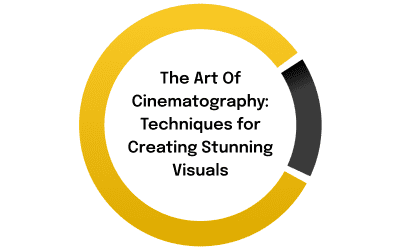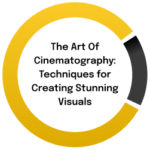Cinematography Techniques for Creating Stunning Visuals
Introduction
Cinematography is an exquisite art that encompasses the capturing and composition of visuals, eliciting emotions, and enhancing the overall cinematic experience. It plays a pivotal role in creating stunning visuals that leave an indelible impact on the audience.
In this comprehensive blog post, we will delve into the important techniques employed by cinematographers to craft visually captivating scenes. From framing and lighting to camera movement and color grading, each element contributes significantly to the art of cinematography.
Framing
At the heart of cinematography lies framing, a fundamental technique that involves the placement and composition of elements within the frame. Framing dictates what the audience sees and how they perceive it. Cinematographers meticulously consider the position, size, and angle of the subjects within the frame to create visually pleasing and meaningful compositions. Techniques like the rule of thirds, leading lines, and symmetry are utilized to guide the viewer’s eye and establish a balanced and aesthetically pleasing image.
Lighting
Lighting stands as an essential aspect of cinematography, capable of dramatically shaping the mood and atmosphere of a scene. Cinematographers employ various lighting techniques to enhance visuals and evoke desired effects. By manipulating the intensity, direction, and color of light, cinematographers craft shadows, highlights, and contrasts.
Whether it’s the soft, diffused light of a romantic scene or the harsh, dramatic lighting of a thriller, proper lighting sets the tone and conveys emotions to the audience, deepening their engagement with the narrative.
Camera Movement
Camera movement injects dynamism and visual interest into a scene. Cinematographers employ an array of techniques such as pans, tilts, dollies, and tracking shots to create different effects. Smooth and steady camera movements can provide a sense of fluidity and grace, while handheld shots can generate a feeling of urgency and intimacy.
Each movement is carefully chosen to complement the story and enhance the visual narrative. The camera becomes a storyteller in itself, guiding the viewer’s perspective and adding depth to the cinematic experience.
Color Grading
Color grading, a post-production process, involves the manipulation and enhancement of colors in a film to establish a desired visual tone and mood. Cinematographers collaborate closely with colorists to achieve the desired look and feel. They adjust color temperature, saturation, and contrast to evoke specific emotions and enhance storytelling.
Warm tones may convey happiness or nostalgia, while cool tones can create a sense of unease or detachment. Skillful color grading can utterly transform a scene, giving it a unique and captivating visual identity.
Conclusion
Cinematography is a potent tool wielded by skilled filmmakers. The techniques discussed in this expansive blog post merely scratch the surface of the vast world of cinematography. By comprehending the principles of framing, lighting, camera movement, and color grading, aspiring cinematographers embark on a transformative journey to create visually stunning and evocative imagery.
Through the artful combination of these techniques, filmmakers breathe life into stories, transport audiences to new worlds, and leave an indelible imprint on viewers. The art of cinematography continues to evolve, pushing boundaries, and inspiring new generations of visual storytellers. It is an ever-evolving art form that holds immense power in the realm of filmmaking, captivating hearts and minds alike.



